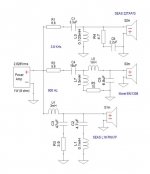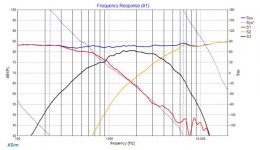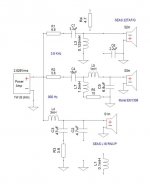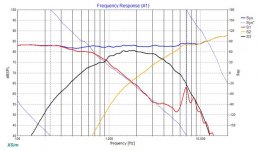Lots of designs use a notch at Fs on tweeters and a Zobel (cap and resistor in parallel) on woofers. But I can't find much on when to use these in my own designs. When do I need/want them?
I know from experience with tweeters that I can't measure if I need a notch or not, but I can hear whether or not I do (I almost always do).
I haven't used a Zobel in anything yet - I haven't seen anything indicating I need one, and it is a little expensive just to throw one on an existing design and see if I can hear the difference.
I'd expect rising impedance would mess with crossover values, and as long as my slopes are where I want them, there'd be no point to a Zobel. Is that correct?
Has anyone notched a woofer at Fs? Why don't you need to? It is more typical to use a woofer closer to Fs than a tweeter.
I know from experience with tweeters that I can't measure if I need a notch or not, but I can hear whether or not I do (I almost always do).
I haven't used a Zobel in anything yet - I haven't seen anything indicating I need one, and it is a little expensive just to throw one on an existing design and see if I can hear the difference.
I'd expect rising impedance would mess with crossover values, and as long as my slopes are where I want them, there'd be no point to a Zobel. Is that correct?
Has anyone notched a woofer at Fs? Why don't you need to? It is more typical to use a woofer closer to Fs than a tweeter.
Good article. Seems to agree that as long as my slopes are where I want them, there's no point adding a Zobel.
I think it's important to point out that there are two reasons for using a notch filter:
- Frequency response such as the ringing at the top of a mid-woofer
- Impedance correction
The latter's main benefits are for high impedance output amplifiers, such as tube amp. The use of such circuits for SS amps is not as clear, though some claim it is still useful. The problem with these of course, is that as you go lower the power dissipation through the notch filter gets worse and worse. It is a lot easier to compensate for the usual tweeter/mid crossover point than the woofer Fs in a sealed box, though some do attempt this.
Best,
E
- Frequency response such as the ringing at the top of a mid-woofer
- Impedance correction
The latter's main benefits are for high impedance output amplifiers, such as tube amp. The use of such circuits for SS amps is not as clear, though some claim it is still useful. The problem with these of course, is that as you go lower the power dissipation through the notch filter gets worse and worse. It is a lot easier to compensate for the usual tweeter/mid crossover point than the woofer Fs in a sealed box, though some do attempt this.
Best,
E
A notch filter might be used to compensate the impedance of a tweeter. One can be used to increase the rate of rolloff of a filter over a small band. One can be used to alter passband response.
Compensating the impedance of a woofer at fs is most useful with a higher output impedance amp. Most wouldn't do it otherwise.
Compensating the impedance of a woofer at fs is most useful with a higher output impedance amp. Most wouldn't do it otherwise.
Zobels are more often than not defined as a shunting CR filter. If this is the case in your usage description, how are you using it? If you are referencing the Zobel as the rarely referred LCR shunt, then I understand you are using it to notch out the Z peak of the tweeter at Fs.
Please clarify,
Wolf
Please clarify,
Wolf
I use the common usage. There is no one specific circuit configuration tied to this.
Zobel network - Wikipedia
Zobel network - Wikipedia
Scrolling down to 'zobel networks and loudspeaker drivers', shows there is no L component in a loudspeaker 'zobel'.
"A parallel circuit of a series resistor and capacitor of the correct values will form a Zobel bridge."
This is one of the reasons an LCR is not classified as a zobel. A true zobel as defined will counteract the inductive rise of the driver.
Later,
Wolf
"A parallel circuit of a series resistor and capacitor of the correct values will form a Zobel bridge."
This is one of the reasons an LCR is not classified as a zobel. A true zobel as defined will counteract the inductive rise of the driver.
Later,
Wolf
I disagree on your finding. I rarely see a notch at Fs, and even if I see many series RC components in a woofer circuit, most of them aren't a Zobel. You can't simply use a cap and a resistor and call that a Zobel. The Zobel network uses calculated components and is used to flatten the impedance and a result you can thus easily calculate the needed components for the LP filter. But frankly with a crossover simulator you don't need it. What you commonly see is a small resistor in series to the cap in a second order network, mainly done to achieve the desired acoustic slope.Lots of designs use a notch at Fs on tweeters and a Zobel (cap and resistor in parallel) on woofers. But I can't find much on when to use these in my own designs. When do I need/want them?
For the Fs notch, you need it with non ferrofluid tweeters to avoid ringing.
Ralf
But frankly with a crossover simulator you don't need it.
Agreed. In the true sense of a zobel, it is rarely needed.
What you commonly see is a small resistor in series to the cap in a second order network, mainly done to achieve the desired acoustic slope.
It's used in more than just a second order, but this is then called a 'damped ___ order xover' with the addition of the resistor to tweak the shape of the 'knee' before rolloff. However, the added resistor itself does not shape the resulting slope/order. The slope or order are inherent to the filter order + driver acoustic rolloff. It does however, shift the phase a few degrees where a better phase alignment can be made in some cases.
For the Fs notch, you need it with non ferrofluid tweeters to avoid ringing.
I also find this is useful in some implementations. It is more usable if the magnitude of the tweeter's Fs is really large. It could be a low Qts tweeter, without FF, and that the magnitude isn't ultimately that large; case in point, it might not be needed even in that case. Sometimes a 15-40 ohm resistor across the tweeter can be effective enough at suppressing the Fs to make it manageable. In all of these criteria, HD and xover point can be make/break as to whether the suppression is ultimately needed or not.
Another CR filter across a tweeter without being a 'true' zobel, can tilt its response down as needed. That's a great trick to have.
Later,
Wolf
Discussion is getting caught up on semantics. For the sake of this thread:
A Zobel is a cap and resistor parallel to a driver that flattens otherwise rising impedance.
A notch filter could be a cap and coil to suppress the ringing of a tweeter, but anything that suppresses a band of frequencies is a notch filter.
A Zobel is a cap and resistor parallel to a driver that flattens otherwise rising impedance.
A notch filter could be a cap and coil to suppress the ringing of a tweeter, but anything that suppresses a band of frequencies is a notch filter.
A notch filter is so-called because it causes a dip, or notch in the driver frequency response. It can be implemented as series, or shunt. You can see this sometimes in Stereophile measurements where random impedance peaks appear in the tweeter band.
A Zobel is no such thing, as it is essentially a high-pass impedance limiting circuit.
The normal case of limiting the tweeter impedance resonance at Fs is not well served by a Zobel. It is also rather rare that this is needed, as the tweeter Fs is usually well below the high pass filter frequency and may not affect the filter roll-off until -30 dB or so. A common exception is some compression which appear at first glance to suffer a big and broad impedance rise before Fs but this mostly disappears after resistive padding.
More useful at times is the use of a notch to limit the peak caused by the low and high pass filter impedance. Again, questionable value for solid-state amps.
Best,
E
A Zobel is no such thing, as it is essentially a high-pass impedance limiting circuit.
The normal case of limiting the tweeter impedance resonance at Fs is not well served by a Zobel. It is also rather rare that this is needed, as the tweeter Fs is usually well below the high pass filter frequency and may not affect the filter roll-off until -30 dB or so. A common exception is some compression which appear at first glance to suffer a big and broad impedance rise before Fs but this mostly disappears after resistive padding.
More useful at times is the use of a notch to limit the peak caused by the low and high pass filter impedance. Again, questionable value for solid-state amps.
Best,
E
Last edited:
For some drivers a Zobel and / or a notch filter are vital.
See the images below for details of my speaker as normal, and then with the Zobel and notch removed.
You can see the aluminium SEAS L18 has a strong breakup peak requiring a notch filter. The SEAS 22TAF/G has a rising response which needs taming with a Zobel.
I'm sure without either the speaker would sound dreadful!
See the images below for details of my speaker as normal, and then with the Zobel and notch removed.
You can see the aluminium SEAS L18 has a strong breakup peak requiring a notch filter. The SEAS 22TAF/G has a rising response which needs taming with a Zobel.
I'm sure without either the speaker would sound dreadful!
Attachments
- Status
- This old topic is closed. If you want to reopen this topic, contact a moderator using the "Report Post" button.
- Home
- Loudspeakers
- Multi-Way
- When to use Zobels and Notch filters



